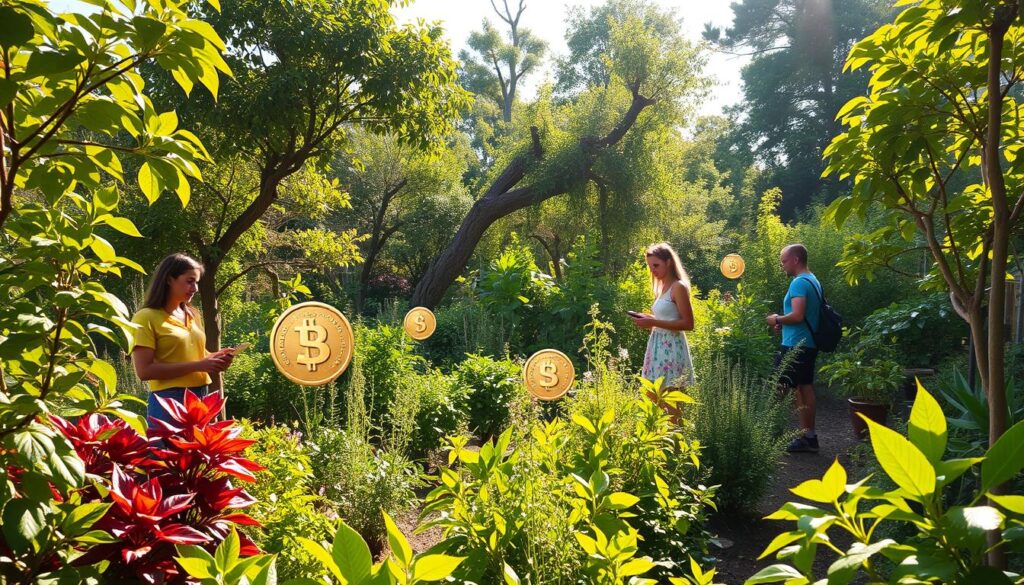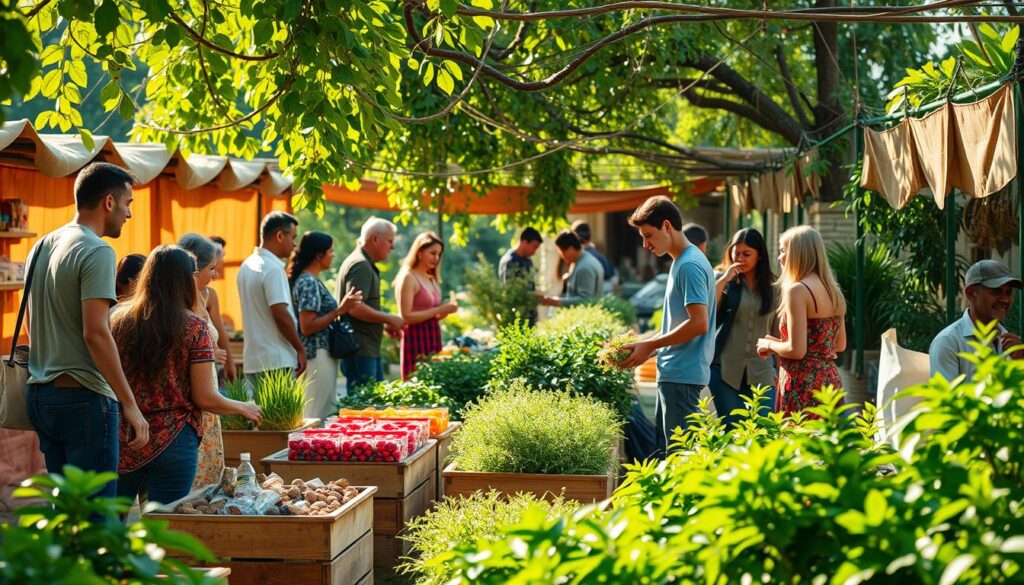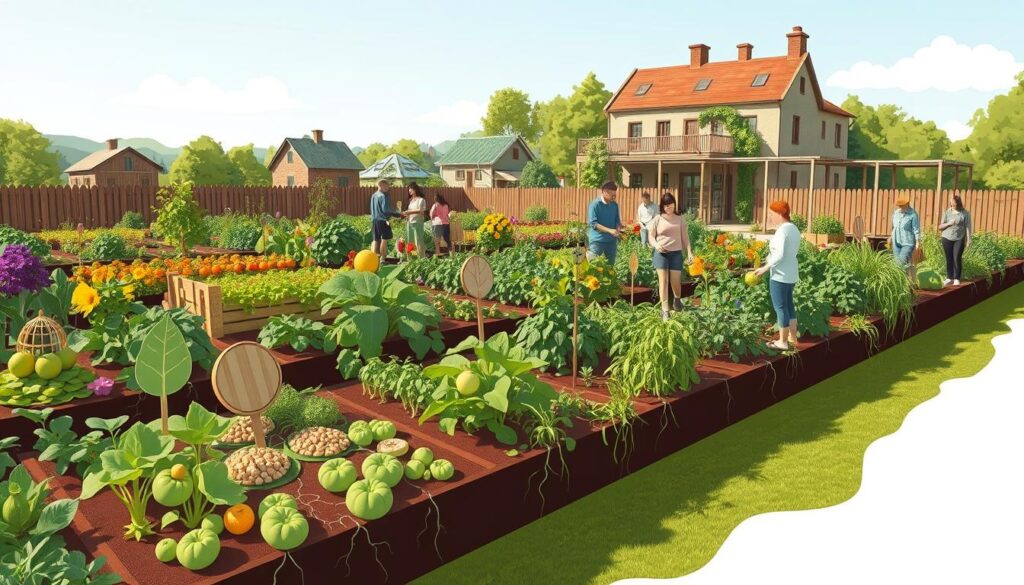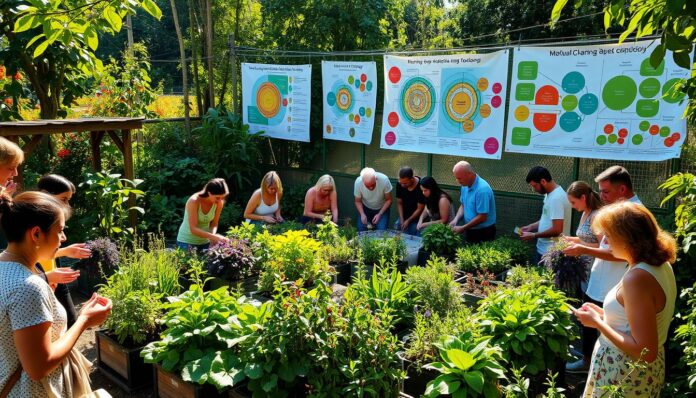In the last 20 years, hundreds of new commons have popped up worldwide. This shows a big interest in new economic systems. Permaculture mutual credit systems are key in this shift. They aim to lessen the harm of old banking and boost green economic growth.
Permaculture is all about making systems that are both sustainable and regenerative. Mutual credit fits right into these goals. It offers a way to manage money that matches permaculture’s values, focusing on green finance and growth.
Key Takeaways
- Mutual credit systems can help strengthen permaculture economies by providing a sustainable and regenerative financial model.
- Permaculture principles emphasize a design that minimizes waste and maximizes yield in local economies, aligning with the concept of multiple forms of capital.
- Financial permaculture is structured to promote total economic return, seeking to optimize all parts of a system, and can be supported through local lending and investment avenues like Slow Money chapters and Worthy.
- The Resilient Investor Map (RIM) can help individuals assess their wealth across various forms of capital, promoting resilience in permaculture economies.
- Mutual credit systems can enhance community wealth-building and promote sustainable economic development, contributing to a more regenerative and sustainable finance system.
- Alternative local currencies and digital autonomous organizations (DAOs) are emerging as governance commons, supporting the growth of permaculture mutual credit systems and regenerative economics.
- Permaculture mutual credit systems can help reduce the environmental impact of traditional banking and promote sustainable economic development, focusing on permaculture mutual credit and sustainable finance.
Introduction to Mutual Credit Systems
Mutual credit systems have been around for centuries. They are becoming more popular as a green alternative to traditional banks. These systems work on the idea of sharing and helping each other out. People and businesses swap goods and services without using money.
This idea is linked to community currency and alternative banking. They both aim to help local economies grow and lessen the harm of traditional banking.
A local exchange trading system is a special kind of mutual credit system. It lets members trade without money. This has worked well in many places, like the West Whitlawburn Housing Co-op in Glasgow. It has 350 members and a long waiting list to join.
Mutual credit systems have many good points. They make it easier for people to get what they need, bring communities closer together, and make local economies stronger. They also encourage people to work together and share resources. This is key for a better future.
By using mutual credit systems, people and businesses can depend less on traditional banks. This helps local economies grow.
- Reciprocity and cooperation among members
- Exchange of goods and services without traditional currency
- Promotion of local economic development and reduced environmental impact
- Increased access to resources and strengthened community ties
In summary, mutual credit systems are a great alternative to traditional banking. They help local economies grow and bring communities together.
The Intersection of Permaculture and Mutual Credit
Permaculture is a way to design sustainable ecosystems. Mutual credit systems support this goal by offering a financial model that fits permaculture’s principles. This integration brings economic benefits like less environmental harm, more local jobs, and stronger community ties.
Permaculture Principles Explained
Permaculture focuses on three key areas: earth care, people care, and fair share. These principles help create a system that’s good for both the planet and people. By following these, permaculture supporters can build an sustainable economic model that encourages local trade and cuts down on traditional money use.
Economic Benefits of Integrating Permaculture
The economic perks of mixing permaculture include:
- Less harm to the environment
- More jobs and growth in local economies
- Stronger community bonds
These advantages come from regenerative economics, which puts the environment and community first.
How Mutual Credit Seeks Sustainability
Mutual credit systems boost sustainability by fostering local trade and cutting down on traditional money use. They work well with permaculture mutual credit systems, aiming for a sustainable financial model.

By combining permaculture and mutual credit, communities can build a sustainable economic model. This model encourages local trade, less environmental harm, and stronger community ties. It’s a step towards a more regenerative economics that values the environment and community well-being.
| Benefits | Description |
|---|---|
| Reduced environmental impact | Permaculture aims to create a sustainable system that helps the environment. |
| Increased local economic development | Mutual credit systems support local trade and reduce traditional currency use. |
| Improved social cohesion | Permaculture and mutual credit foster community and cooperation. |
How Mutual Credit Works
Mutual credit systems are based on giving and taking without using money. They are part of a bigger ecological financial system that supports sustainable finance. These systems help people and businesses trust and work together.
At the heart of mutual credit is a network where everyone can trade and settle accounts. It’s all about working together and trusting each other. For example, local exchange trading systems and time banks show how mutual credit can boost local economies and support sustainable growth.
Some key benefits of mutual credit systems include:
- Affordable credit for participants without relying on traditional banks
- Reduced burden of high-interest loans
- Increased access to resources and services
As a mutual credit platform, it aims to create a better financial system. One that cares more about people and the planet than making money. Mutual credit encourages cooperation and helps build stronger, more resilient communities.
Mutual credit systems offer a hopeful alternative to traditional finance. They focus on working together, giving back, and caring for our planet.
| Mutual Credit System | Traditional Financial System |
|---|---|
| Based on cooperation and reciprocity | Based on competition and profit |
| Promotes sustainable finance practices | Prioritizes profit over sustainability |
| Provides affordable credit to participants | Often imposes high-interest rates |
Case Studies of Mutual Credit in Permaculture
Permaculture mutual credit systems have shown great success in different projects. They help in promoting sustainable economic growth. These systems follow the principles of regenerative economics, aiming for a fair and green economic model.
The Credit Commons is a global mutual credit system. It lets users trade goods and services with any local currency. This supports local economies and permaculture practices by creating new economic ties.
Successful Permaculture Projects Utilizing Mutual Credit
- The Permies Federal Credit Union (PFCU) offers an alternative financial model. It can help at various levels for community members.
- The Permaculture Development model could benefit from investment. It mirrors successful examples like Wheaton Labs and other community-focused land projects.

Lessons Learned from Case Studies
These case studies show the key role of community engagement, trust, and cooperation. They highlight mutual credit’s potential in supporting sustainable economic growth. They also show its role in promoting regenerative economics.
| Project | Location | Outcomes |
|---|---|---|
| Credit Commons | Global | Alternative economic relationships, local economic support |
| Permies Federal Credit Union | USA | Alternative financial model, community support |
Benefits of Mutual Credit for Permaculture Practitioners
Permaculture practitioners can get a lot from mutual credit systems. They can get tools, equipment, and expertise they need. This is because they join a local exchange trading system.
Using community currency and alternative banking helps build strong community ties. It makes people work together and support each other. This leads to a stronger local economy.
- More access to resources and services
- Stronger community ties and cooperation
- A more resilient local economy
These advantages come from using local exchange trading systems, community currency, and alternative banking. They offer a better way than traditional financial systems.
| Benefit | Description |
|---|---|
| Increased access to resources | Joining a local exchange trading system gives access to tools, equipment, and expertise |
| Strengthened community ties | Community currency and alternative banking systems promote cooperation and reciprocity among participants |
| Enhanced resilience in local economies | Mutual credit systems can lead to a more resilient local economy, where members support each other and work together |
Challenges in Implementing Mutual Credit Systems
Setting up mutual credit systems is not easy. They face many challenges. A mutual credit platform is part of an ecological financial system. It helps by making exchange and reciprocity easier among people.
But, there are regulatory obstacles that can slow them down. These systems aim to support sustainable finance.
Getting people involved is key to success. Mutual credit systems work best when everyone works together. This means keeping things open and building trust.
For example, the WIR Bank in Switzerland shows how it can work. It supports local economies well.
Some big challenges include:
- Regulatory compliance: Making sure the system fits with current financial laws.
- Community participation: Getting more people to join and be active.
- Transparency and trust: Keeping things clear and building trust among everyone.
A good mutual credit platform can help make finance more sustainable. It supports local economies and promotes ecological financial systems. By tackling these challenges, communities can build strong mutual credit systems that help everyone.

The Role of Technology in Mutual Credit
Technology is key in making permaculture mutual credit systems work. It helps create digital platforms for these projects. This makes it easy for people to trade, talk, and find resources.
Using blockchain and decentralized systems is a big part of this. They keep transactions safe and honest. Also, new tools like mobile payments and online markets make it easier for more people to join in. This way, mutual credit systems help grow the economy in a green way.
To learn more about permaculture, check out permaculture practice. They talk about how permaculture helps animals and supports green farming.
Technology makes mutual credit systems better by giving more people access. It also helps communities stick together and makes local economies stronger. By using new tech, mutual credit can become a great choice for those wanting to help the planet and grow their economy.
| Technology | Application in Mutual Credit |
|---|---|
| Digital Platforms | Recording and settling transactions, facilitating communication |
| Blockchain and Decentralized Systems | Providing a secure and transparent means of recording transactions, maintaining trust |
| Mobile Payments and Online Marketplaces | Enhancing access to mutual credit systems, making them more inclusive and user-friendly |
The Future of Mutual Credit in Sustainable Agriculture
The world is moving towards more sustainable ways, and mutual credit in permaculture is playing a big role. This is because of the rise in regenerative economics and the need for a sustainable economic model. Permaculture mutual credit systems are becoming more common, offering a hopeful solution for local economies.
Adding mutual credit to sustainable agriculture will change global agricultural policies a lot. It helps promote sustainable farming and lessens environmental harm. This supports a regenerative economics approach, focusing on caring for the environment and community well-being.
Predictions for Growth in Permaculture Systems
Several things are driving the growth of mutual credit in permaculture. These include growing awareness of sustainable farming, the benefits of regenerative economics, and mutual credit’s role in local economies. As more communities adopt permaculture and aim for a sustainable economic model, the need for mutual credit will likely rise.
Evolving Economic Models
New economic models, like the circular and sharing economies, might include mutual credit. These models focus on sustainability, cutting down waste, and boosting community involvement. They align with permaculture and regenerative economics. By adding mutual credit, they can have even more positive effects on sustainability and regeneration.
| Model | Description | Impact |
|---|---|---|
| Circular Economy | Designs out waste and pollution | Reduces environmental degradation |
| Sharing Economy | Promotes sharing of resources | Encourages community engagement and reduces waste |
Building a Mutual Credit Network
Creating a mutual credit network is key to supporting community currency and alternative banking. It uses a local exchange trading system. Here, people trade goods and services without traditional money.
To start a mutual credit system, knowing the community’s needs and goals is important. You need a governance structure and a way to record and settle trades.
Steps to Initiate a Mutual Credit System
- Identify the needs and goals of the community
- Establish a governance structure
- Create a system for recording and settling transactions
Working together is essential for a mutual credit system’s success. Offer education and training. Also, keep improving the system.

Best Practices for Effective Implementation
Keeping things transparent and trustworthy is vital. Give regular updates and make sure everyone understands the system.
By following these steps and best practices, communities can build a strong mutual credit network. This supports community currency and alternative banking through local trading.
Education and Awareness for Mutual Credit
Education and awareness are key for mutual credit systems to thrive. They need community members to understand and join in. A mutual credit platform helps control resources locally, making local economies stronger.
By using an ecological financial system, communities can manage resources better. This leads to self-reliance and sustainability. Workshops and training help community members learn about mutual credit.
Online courses and publications are also great resources for learning. Local groups and cooperatives can help spread the word. This supports a sustainable finance system.
Important parts of education and awareness for mutual credit include:
* Making sure everyone can make decisions together
* Encouraging local self-reliance to control resources better
* Building trust and transparency for a strong system
By focusing on these, communities can build a solid mutual credit system. This helps create a sustainable and resilient local economy.
Integrating Mutual Credit with Local Currencies
Local currencies help keep money in the community, boosting local businesses. For example, the Brixton Pound aims to keep 50-100% of local economic energy in Brixton. This can be paired with mutual credit systems for a stronger economy.
Regenerative economics aims to keep wealth in the community. By combining mutual credit with local currencies, we can support local businesses. This helps grow the local economy and reduces harm to the environment.

Studies show local currencies can boost business revenue by up to 20%. Community-supported agriculture (CSA) projects, which use local currencies, keep 87% of their spending local. This approach, seen in permaculture practice, supports a sustainable economic model.
Policy Recommendations for Supporting Mutual Credit
To help mutual credit systems grow, we need to support them with the right policies. This means making financial services more accessible. It also helps in promoting community currency and alternative banking.
Working with governments can give mutual credit systems the boost they need. This support can help them reach more people. By focusing on local exchange trading system and sustainable practices, they can make local economies stronger.
Here are some key policy suggestions to support mutual credit:
- Lowering rules for new mutual credit systems
- Offering money and resources for learning and training
- Supporting partnerships between mutual credit systems and governments
By following these policy tips, we can make a better space for mutual credit systems to flourish. This will help build stronger, more sustainable local economies.
| Policy Recommendation | Benefits |
|---|---|
| Reducing regulatory barriers | Encourages new mutual credit systems to emerge |
| Providing funding and resources | Supports education and training programs |
| Encouraging partnership | Fosters collaboration between mutual credit systems and government entities |
The Role of Social Capital in Mutual Credit
Social capital is key in mutual credit systems. It helps communities trust and work together. A mutual credit platform needs the trust and cooperation of its members to work well. This is crucial for a sustainable finance model that helps everyone in the community.
Building trust is vital for mutual credit systems to succeed. This can happen through community events, workshops, and online forums. These activities help create a sense of community and fairness in finance.
Building Trust in Communities
Trust is the base of any good mutual credit system. It grows from repeated interactions and a shared sense of responsibility. In a mutual credit platform, trust is key to ensure members keep their promises and work together.
The Importance of Relationships
Relationships are vital in mutual credit systems. Strong, personal connections help build trust and cooperation. In a sustainable finance model, these relationships are essential for a sense of community and shared goals.
Networking for Mutual Benefit
Networking is crucial in mutual credit systems. It helps community members share resources and work together for everyone’s benefit. In an ecological financial system, networking supports a fair and sustainable financial model.
- Building trust in communities through repeated interactions and shared responsibility
- Creating strong, personal connections with one another to foster a sense of cooperation and reciprocity
- Networking for mutual benefit to create a sense of shared responsibility and cooperation
Understanding social capital’s role in mutual credit systems is important. It helps create a fair and sustainable financial model for the community. A mutual credit platform based on social capital supports an ecological financial system that meets local needs.
Measuring Success in Mutual Credit Systems
It’s key to measure success in mutual credit systems. This helps us see how they help permaculture economies grow. A sustainable economic model like mutual credit works best when everyone is involved and there are lots of trades.
Success can be checked by looking at how many people are involved, how many trades happen, and how it helps the local economy. Tools like surveys and focus groups give us clues on how well a mutual credit system is doing. They help us see what’s working and what needs work.
Improving a mutual credit system is important. Regular meetings and listening to feedback are key to making it better. This helps the system grow and help the community more.
Criteria for Success
For a mutual credit system to succeed, it needs lots of people involved and lots of trades happening. It works best when it’s part of the local economy. This helps regenerative economics by making it easier for people to work together.
Success also means helping the local economy grow. A permaculture mutual credit system should be strong and able to keep going. It should help the community in many ways.
Tools for Evaluation
There are many ways to check if a mutual credit system is doing well. Here are a few:
- Surveys to hear what participants think
- Focus groups to talk about what’s working and what’s not
- Looking at how many trades happen to see if the economy is growing
Using these tools helps make mutual credit systems better. They help them work better for regenerative economics and support sustainable economic models.
| Criteria | Tools for Evaluation | Continuous Improvement Practices |
|---|---|---|
| Participation Level | Surveys, Focus Groups | Regular Meetings, Feedback Sessions |
| Transaction Volume | Transaction Volume Analysis | Adjustments to System Parameters |
| Local Economic Impact | Economic Impact Studies | Strategic Planning, Community Engagement |
Conclusion: The Path Forward for Permaculture and Mutual Credit
As we’ve explored, combining
permaculture
and
mutual credit
systems is very promising. It helps create a more
regenerative economics
and
sustainable economic model
. We’ve seen how mutual credit supports permaculture’s core values. It helps communities become more resilient, self-sufficient, and environmentally conscious.
The future looks bright as we work together. We need to keep growing community involvement and spreading the word about these new economic models. By getting more people and groups involved in mutual credit, we can build a strong, local economy that matches permaculture’s values. This will take ongoing efforts in policy, technology, and connecting with other financial systems like local currencies.
Our vision is of a thriving, decentralized, and regenerative economy. As permaculture and mutual credit grow together, we can see a world where sustainable food, fair resources, and community focus are common. This partnership opens doors to a resilient and harmonious future.

